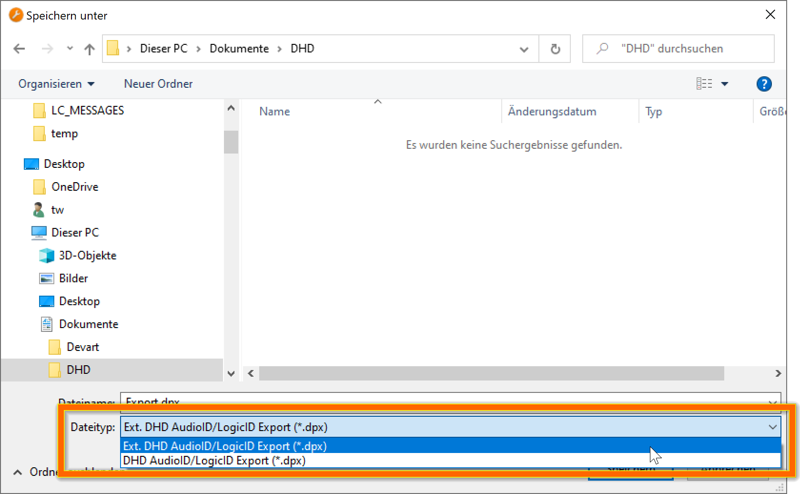This connection type implements the DHD External Control Protocol (ECP) for mixing consoles and routers from DHD.audio GmbH.
Supported Devices and Prerequisites
The following devices are supported:
- All series 52 cores and consoles
- RM4200D
- Fully supported if running on Firmware 5.x
- Partial support for Firmware 4.x (routing not implemented at this time)
Only TCP/IP connections are supported, no serial port connections.
Configuration
General Tab
Connection-specific settings:
- Network connection: Enter IP/host and port number (usually 2008) of the core.
- Fader Level Notification (only supported for Firmware 7.x): Choose either Channel-based or Fader-based to enable instant notification of fader level, either based on fader channels or by physical faders.
Elements Tab
Click the Load Toolbox Data to import information about your core
from an Extended DHD AudioID/LogicID Export (*.dpx) file.
This file can be created from the DHD Toolbox application (Project -> Export -> Export AudioIDs/LogicIDs).

Important
Make sure that you set the file type to Extended (Ext.) output in the Save dialog in Toolbox.After importing the file into BTConnect, the various tabs (Logics, Channels, Routings) will be filled with the IDs and descriptions from the Toolbox file. (If there is more than one device in your Toolbox project, and thus in the export file, you will be first asked which device should be imported for this connection.)
Additional information can be entered manually on the tabs:
- Logics: Enter an optional description that will be used in the GUI rather than the default string imported from Toolbox. Optionally, check a logic for which the current state should be queries when BTConnect starts. (All other logics remain in “unknown” state until the first update is received from the core.)
- Channels: Enter an optional description for each fader channel.
- Faders: Enter an optional description for each fader of each virtual mixer.
- Routing: Check the Req box in order to request the state of a particular routing on startup. Check Enable routing crosspoint notifications in order to receive instant updates when routing changes.
Parameters
The following parameters are provided by ECP connections:
Logics
logic/<id>(boolean, read/write) - the state of the logic with the number<id>(1-4095)
Fader Channels
<number> refers to channel number as given in Toolbox.
channel/<number>/start(boolean, write-only) - switch channel on or off. Note: This parameter is write-only, the current state can only be retrieved via logics.channel/<number>/pfl(boolean, write-only) - turn PFL on or off. Note: write-only, use logics to retrieve status.channel/<number>/level(float, write-only or read/write) - set fader of the channel to the specified level (in dB, range -32.768..+10). If Level Notification is set to “Channel-based” in the configuration, this parameter is read/write, and indicates current fader level, e.g. when operated manually on the console.channel/<number>/timedlevel(string, write-only) - set fader of the channel to the specified level (in dB, range -32.768..+10), within the specified time (in milliseconds) and with a curve of either level linear (0) or fader linear (1). The value must be encoded as a string in the form<level>,<time>,<curve>, or just<level>,<time>; in the latter case, linear fade (0) is used.
Faders
<mixer> refers to virtual mixer (1..4).
<fader> refers to fader (1..48) of that virtual mixer.
mixer/<mixer>/fader/<number>/start(boolean, write-only) - switch fader on or off. Note: This parameter is write-only, the current state can only be retrieved via logics.mixer/<mixer>/fader/<number>/pfl(boolean, write-only) - turn PFL for this fader on or off. Note: write-only, use logics to retrieve status.mixer/<mixer>/fader/<number>/level(float, write-only or read/write) - set fader to the specified level (in dB, range -32.768..+10). If Level Notification is set to “Fader-based” in the configuration, this parameter is read/write, and indicates current fader level, e.g. when operated manually on the console.mixer/<mixer>/fader/<number>/timedlevel(string, write-only) - set fader to the specified level (in dB, range -32.768..+10), within the specified time (in milliseconds) and with a curve of either level linear (0) or fader linear (1). The value must be encoded as a string in the form<level>,<time>,<curve>, or just<level>,<time>; in the latter case, linear fade (0) is used.
Potentiometer (Monitor Level)
potentiometer/<id>(float, write-only) - Level of the potentiometer/monitor channel (in dB)
Routing
routing/<output ID>(string, read/write) - the input audio ID of the signal currently routed to the specified output audio ID. Audio IDs are specified as a 4-digit (Toolbox 4) or 8-digit (Toolbox 5-9) hex number.
Routing is generally based on mono channels in a DHD system, so all outputs are mono, and all inputs are mono as well; thus, a stereo output (input) is represented by two mono outputs (inputs), and in order to route a stereo input to a stereo output, two mono routes must be set.
In order to facilitate the routing of stereo signals, BTConnect will create three parameters for all stereo outputs: one for the left channel, one for the right channel, and one “virtual” stereo parameter (with the stereo bit set in the audio ID). Assigning a mono input ID to this virtual stereo parameter will route that mono signal to both outputs; setting it to a stereo audio ID (with the stereo bit) will send two routing commands for the left and the right channel.